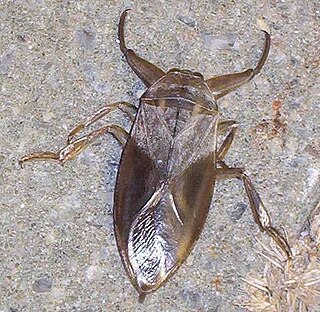
The Aphididae are a very large insect family in the aphid superfamily (Aphidoidea), of the order Hemiptera. Several thousand species are placed in this family, many of which are well known for being serious plant pests. They are also the family of insects containing most plant virus vectors with the green peach aphid being one of the most prevalent and indiscriminate carriers.
Anoeciinae is a subfamily of the family Aphididae. Anoeciines live underground and feed on the roots of plants.

The Braconidae are a family of parasitoid wasps. After the closely related Ichneumonidae, braconids make up the second-largest family in the order Hymenoptera, with about 17,000 recognized species and many thousands more undescribed. One analysis estimated a total between 30,000 and 50,000, and another provided a narrower estimate between 42,000 and 43,000 species.

Alexandr Pavlovich Rasnitsyn is a Russian entomologist, expert in palaeoentomology, and Honored Scientist of the Russian Federation (2001). His scientific interests are centered on the palaeontology, phylogeny, and taxonomy of hymenopteran insects and insects in general. He has also studied broader biological problems such as evolutionary theory, the principles of phylogenetics, taxonomy, nomenclature, and palaeoecology. He has published over 300 articles and books in several languages. In August 2008 he was awarded the Distinguished Research Medal of the International Society of Hymenopterists.
Signiphoridae is a small family of parasitic wasps in the superfamily Chalcidoidea. The roughly 80 species are placed in four genera.

The Polyceridae are a taxonomic family of sea slugs, dorid nudibranchs, marine gastropod mollusks within the superfamily Polyceroidea.

Rhopalosiphum is a genus of aphid of the family Aphididae that includes 16 species worldwide. Apart from sucking the phloem of host plants and thereby being treated in agriculture as pests, some species are vectors for viral pathogens.

Lethocerus is a genus of the hemipteran family Belostomatidae, known colloquially as giant water bugs, distributed in tropical, subtropical and temperate areas of the world. The greatest diversity of species occurs in the Americas, with only a single species in Europe, two in Africa, two in Australia and three in Asia. It includes the largest true bugs with species capable of reaching a length of over 12 centimetres (4.7 in). The South American L. grandis and L. maximus are the only species to commonly exceed 9 cm (3.5 in), with more typical lengths for the remaining species being between 4.5 and 9 cm. Lethocerus sp. are distinguished from other genera in the Lethocerinae by two symmetrical furrows in the inner pad of setae on the fore femur, the external borders of parasternites II and III narrowed and nearly straight, and with the setae of the tarsomeres following the line of the tibial setae.

Phylloxeridae is a small family of plant-parasitic hemipterans closely related to aphids with only 75 described species. This group comprises two subfamilies and 11 genera with one that is fossil. The genus type is Phylloxera. The Phylloxeridae species are usually called Phylloxerans or Phylloxerids.
Baltichaitophorinae is a subfamily of the family Aphididae.
Idiopterus is a genus of aphid insect. The type species is Idiopterus nephrelepidis.
Idiopterus nephrelepidis, commonly known as the black fern aphid, is a species of aphid insect that feeds on various species of fern. It is the type species of the genus Idiopterus.
Ellinaphididae is an extinct family of aphids in the order Hemiptera. There are about 13 genera and more than 40 described species in Ellinaphididae.
Isolitaphididae is an extinct family of aphids in the order Hemiptera. There are at least three genera in Isolitaphididae.
Juraphididae is an extinct family of aphids in the order Hemiptera. There are at least three genera and about five described species in Juraphididae. The most recent discovery in Juraphididae family was the Prolavexillapis munditia in 2018 and Isolitaphidae are synonymy with the Juraphididae
Lebanaphididae is an extinct family of aphids in the order Hemiptera. There are at least two genera in Lebanaphididae.
Mesozoicaphididae is an extinct family of aphids in the order Hemiptera. There are at least four genera and about seven described species in Mesozoicaphididae.
Szelegiewicziidae is an extinct family of aphids in the order Hemiptera. There are about 6 genera and 10 described species in Szelegiewicziidae.








